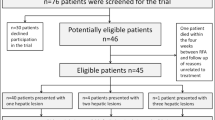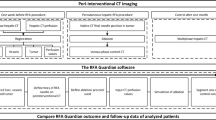Abstract
Purpose
Radiofrequency ablation (RFA) is one of the most popular and well-standardized minimally invasive cancer treatments (MICT) for liver tumours, employed where surgical resection has been contraindicated. Less-experienced interventional radiologists (IRs) require an appropriate planning tool for the treatment to help avoid incomplete treatment and so reduce the tumour recurrence risk. Although a few tools are available to predict the ablation lesion geometry, the process is computationally expensive. Also, in our implementation, a few patient-specific parameters are used to improve the accuracy of the lesion prediction.
Methods
Advanced heterogeneous computing using personal computers, incorporating the graphics processing unit (GPU) and the central processing unit (CPU), is proposed to predict the ablation lesion geometry. The most recent GPU technology is used to accelerate the finite element approximation of Penne’s bioheat equation and a three state cell model. Patient-specific input parameters are used in the bioheat model to improve accuracy of the predicted lesion.
Results
A fast GPU-based RFA solver is developed to predict the lesion by doing most of the computational tasks in the GPU, while reserving the CPU for concurrent tasks such as lesion extraction based on the heat deposition at each finite element node. The solver takes less than 3 min for a treatment duration of 26 min. When the model receives patient-specific input parameters, the deviation between real and predicted lesion is below 3 mm.
Conclusion
A multi-centre retrospective study indicates that the fast RFA solver is capable of providing the IR with the predicted lesion in the short time period before the intervention begins when the patient has been clinically prepared for the treatment.


Similar content being viewed by others
References
Bray F, Jemal A, Grey N, Jacques F, Forman D (2012) Global cancer transitions according to the human development index (2008–2030): a population-based study. Lancet Oncol 13(8):790–801
Bruix J, Sherman M (2011) Management of hepatocellular carcinoma: an update. Hepatology 53(3):1020–1022
Audigier C, Mansi T et al (2015) Efficient lattice Boltzmann solver for patient-ppecific radiofrequency ablation of hepatic tumors. IEEE Trans Med Imaging 34(7):1576–1589
Masunaga S, Ono K et al (1996) Clinical usefulness of determining the rate of thermal clearance within heated tumours. Jpn J Clin Oncol 26(6):428–437
Van Beers BE, Leconte I et al (2001) Hepatic perfusion parameters in chronic liver disease: dynamic CT measurements correlated with disease severity. AJR AM J Roentgenol 176(3):667–673
Huang HW (2013) Influence of blood vessel on the thermal lesion formation during radiofrequency ablation for liver tumors. Med Phys 40(7):73303-1–73303-13
Hall SK, Ooi EH, Payne SJ (2015) Cell death, perfusion and electrical parameters are critical models of hepatic radiofrequency ablation. Int J Hyperthermia 31(5):538–550
Audigier C, Mansi T et al (2014) Parameter estimation for personalization of liver tumor radiofrequency ablation. In: Abdominal imaging. Computational and clinical applications: 6th international workshop, MICCAI (2014). Lecture Notes in Computer Science, vol 8876. Springer, Cambridge, pp 3–12
Khlebnikov R, Muehl J (2010) Effects of needle placement inaccuracies in hepatic radiofrequency tumor ablation. Conf Proc IEEE Eng Med Bio Soc 716–721
Villard C, Soler L, Gangi A (2005) Radiofrequency ablation of hepatic tumors: simulation, planning, and contribution of virtual reality and hepatics. Comput Methods Biomech Biomed Eng 8(4):215–227
Abdullah BJ, Yeong CH et al (2014) Robot-assisted radiofrequency ablation of primary and secondary liver tumours: early experience. Eur Radiol 24(1):79–85
Jain MK, Wolf PD (1999) Temperature-controlled and constant-power radio-frequency ablation: what affects lesion growth? IEEE Trans Biomed Eng 46(12):1405–1412
Liang HH, Peng ZW et al (2010) Efficacy of combining temperature- and power-controlled radiofrequency ablation for malignant liver tumors. Chin J Cancer 29(4):408–412
Goldberg SN (2001) Radiofrequency tumour ablation: principles and techniques. Eur J Ultrasound 13(2):129–147
Angiodynamics (2015) RITA 1500X User’s guide and service manual. http://www.angiodynamics.com/uploads/pdf/042210-040340_RITA1500XIFU.pdf Accessed 10 Oct 2015
AngioDynamics (2015) RITA starburst model 75, StartBurst SDE electrosurgical device, starburst XL electrosurgical device, MRI compatible StarBurst XL device, MRI compatible StarBurst semi-flex electrosurgical device instructions for USE. http://www.angiodynamics.com/uploads/pdf/051514-084641_160-104121Rev06[1].pdf Accessed 10 Oct 2015
Shumann C, Rieder C, Haase S et al (2015) Interactive multi-criteria planning for radiofrequency ablation. Int J Comput Assist Radiol Surg 10(6):879–889
Kröger T, Altrogge I et al (2006) Numerical simulation of radio frequency ablation with state dependent material parameters in three space dimensions. Med Image Comput Assist Interv 9(Pt 2):380–388
Jia X, Yan G, Gu X, Jiang SB (2012) Fast Monte Carlo simulation for patient-specific CT/CBCT imaging dose calculation. Phys Med Biol 57(3):577
Jia X, Lou Y, Lewis J et al (2011) GPU-based fast low-dose cone beam CT reconstruction via total variation. J Xray Sci Technol 19(2):139–154
NVIDIA Corporation (2015) NVIDIA CUDA C programming guide, Version 7.0. docs.nvidia.com/cuda/cuda-c-programming-guide/. Accessed 12 Dec 2015
Cheng J, Grossman M, McKercher T (2014) Professional CUDA C programming. John & Wiley Sons Inc., Indianapolis
Pennes HH (1948) Analysis of tissue and arterial blood temperature in the resting human forearm. J Appl Physiol 1(2):93–122
Kröger T, Pätz T et al (2010) Fast estimation of the vascular cooling in RFA based on numerical simulation. Open Biomed Eng J 4:16–26
Rieder C, Kroeger T, Schumann C, Hahn HK (2011) GPU-based real-time approximation of the ablation zone for radiofrequency ablation. IEEE Trans Vis Comput Graph 17(12):1812–1821
Borsic A, Hoffer E, Attardo EA (2014) GPU-accelerated real time simulation of radio frequency ablation thermal dose. In: 40th annual northeast bioengineering conference (NEBEC)
O’Neill DP, Peng T et al (2011) A three-state mathematical model of hyperthermic cell death. Ann Biomed Eng 39(1):570–579
Payne S, Flanagan R et al (2011) Image-based multi-scale modelling and validation of radio frequency ablation in liver tumours. Phil Trans R Soc A 369:4233–4254
Alhonnoro T, Pollari M et al (2010) Vessel Segmentation for ablation treatment planning and simulation. Med Image Comput Comput Assist Interv 13(Pt 1):45–52
Nolden M, Zelzer S et al (2013) The medical imaging interaction toolkit: challenges and advances: 10 years of open-source development. Int J Comput Assist Radiol Surg 8(4):607–620
Goetti R, Reiner CS et al (2012) Quantitative perfusion analysis of malignant liver tumors: dynamic computed tomography and contrast-enhanced ultrasound. Invest Radiol 47(1):18–24
Van Amerongen MJ, Garnov N et al (2016) Liver CT perfusion values for colorectal liver metastases—a protocol for future use in radiofrequency simulation software. In: Insights into imaging: ECR 2016 Book of Abstracts-C-Scientific and Educational Exhibits
Stoer J, Bulirsch R (2002) Introduction to numerical analysis, 3rd edn. Springer, Berlin
Astrom K, Hägglund T (1995) PID controllers, theory, design and tunning, 2nd edn. Instrument Society of America, Research Triangle Park
Eisenberg MA, Malvern LE (1973) On finite element integration in natural coordinates. Int J Numer Meth Engng 7(4):574–575
Ebbini ES, Umemura SI, Ibbini M, Cain CA (1988) A cylindrical-section ultrasound phased-array applicator for hyperthermia cancer therapy. IEE Trans Ultrson Ferroelectr Freq Control 35(5):561–572
Werner J, Buse M (1988) Temperature profiles with respect to inhomogeneity and geometry of the human body. J Appl Physiol 65(3):1110–1118
Iturralde P, Guevara-Valdivia M, Laura R, Argelia M, Luis C (2002) Radiofrequency ablation of multiple accessory pathways. Europace 4(3):273–280
Quan YS, He Q, Wang MQ (2012) Transcatheter arterial chemoembolization: history for more than 30 Years. ISRN Gastroenterol 2012 (Article ID 480650):8
Author information
Authors and Affiliations
Corresponding author
Ethics declarations
Conflict of interest
None.
Additional information
This research work is part of seventh Framework Programme (FP7) Project Clinical Intervention Modelling, Planning and Proof for Ablation Cancer Treatment (ClinicIMPPACT, http://www.clinicimppact.eu) and it is co-funded by the European commission under Grant Agreement Number 610886.
Rights and permissions
About this article
Cite this article
Mariappan, P., Weir, P., Flanagan, R. et al. GPU-based RFA simulation for minimally invasive cancer treatment of liver tumours. Int J CARS 12, 59–68 (2017). https://doi.org/10.1007/s11548-016-1469-1
Received:
Accepted:
Published:
Issue Date:
DOI: https://doi.org/10.1007/s11548-016-1469-1




